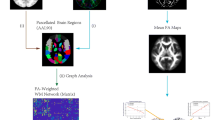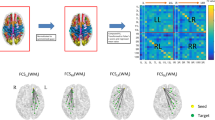Abstract
To categorize and clinically characterize subtypes of brain structural connectivity patterns in unilateral temporal lobe epilepsy (TLE). Voxel based morphometry (VBM) and surfaced based morphometry (SBM) analysis were used to detect brain structural alterations associated with TLE from MRI data. Principal component analysis (PCA) was performed to identify subtypes of brain structural connectivity patterns. Correlation analysis was used to explore associations between PC scores and clinical characteristics. A total of 59 patients with TLE and 100 healthy adults were included in this study. Widespread cortical atrophy was shown in both left and right TLE (P < 0.05, FWE corrected). Six principal components (PCs) that explained more than 70% of the variance were extracted for left and right TLE, reflecting patterns of brain structural connectivity. PCs representing perisylvian connectivity were positively correlated with verbal IQ (left TLE: r = 0.696, P < 0.001; right TLE: r = 0.484, P = 0.012) and total IQ (left TLE r = 0.608, P < 0.001) and negatively correlated with disease duration (r = −0.448, P = 0.009). In left TLE, the PC in the ipsilateral mesial temporal region was negatively correlated with age at onset (r = −0.382, P = 0.028). In right TLE, the PC representing the default mode network was negatively correlated with number of antiepileptic drugs (r = −0.407, P = 0.039). This study categorized subtypes of unilateral TLE based on brain structural connectivity patterns. Findings may provide insight into seizure pathways, the pathophysiology of epilepsy, including comorbidities such as cognitive impairment, and help predict treatment outcomes.




Similar content being viewed by others
Data availability
All data generated and analyzed during this study are included in this published article. The transcripts from which this manuscript was developed are available on request from the corresponding author.
References
Alhusaini, S., Whelan, C. D., Doherty, C. P., et al. (2016). Temporal cortex morphology in mesial temporal lobe epilepsy patients and their asymptomatic siblings. Cerebral Cortex, 26(3), 1234–1241. https://doi.org/10.1093/cercor/bhu315
Alvim, M. K., Coan, A. C., Campos, B. M., et al. (2016). Progression of gray matter atrophy in seizure-free patients with temporal lobe epilepsy. Epilepsia, 57(4), 621–629. https://doi.org/10.1111/epi.13334
Balachandra, A. R., Kaestner, E., Bahrami, N., et al. (2020). Clinical utility of structural connectomics in predicting memory in temporal lobe epilepsy. Neurology, 94(23), e2424–e2435. https://doi.org/10.1212/WNL.0000000000009457
Barron, D. S., Fox, P. M., Laird, A. R., Robinson, J. L., & Fox, P. T. (2012). Thalamic medial dorsal nucleus atrophy in medial temporal lobe epilepsy: A VBM meta-analysis. NeuroImage Clinical, 2, 25–32. https://doi.org/10.1016/j.nicl.2012.11.004
Berg, A. T., Berkovic, S. F., Brodie, M. J., et al. (2010). Revised terminology and concepts for organization of seizures and epilepsies: Report of the ILAE commission on classification and terminology, 2005-2009. Epilepsia, 51(4), 676–685. https://doi.org/10.1111/j.1528-1167.2010.02522.x
Bernasconi, N. (2016). Is epilepsy a curable neurodegenerative disease? Brain, 139(Pt 9), 2336–2337. https://doi.org/10.1093/brain/aww202
Bernhardt, B. C., Bernasconi, N., Concha, L., & Bernasconi, A. (2010). Cortical thickness analysis in temporal lobe epilepsy: Reproducibility and relation to outcome. Neurology, 74(22), 1776–1784. https://doi.org/10.1212/WNL.0b013e3181e0f80a
Bernhardt, B. C., Bernasconi, N., Kim, H., & Bernasconi, A. (2012). Mapping thalamocortical network pathology in temporal lobe epilepsy. Neurology, 78(2), 129–136. https://doi.org/10.1212/WNL.0b013e31823efd0d
Bernhardt, B. C., Hong, S., Bernasconi, A., & Bernasconi, N. (2013). Imaging structural and functional brain networks in temporal lobe epilepsy. Frontiers in Human Neuroscience, 7, 624. https://doi.org/10.3389/fnhum.2013.00624
Bernhardt, B. C., Fadaie, F., Vos de Wael, R., et al. (2018). Preferential susceptibility of limbic cortices to microstructural damage in temporal lobe epilepsy: A quantitative T1 mapping study. Neuroimage, 182, 294–303. https://doi.org/10.1016/j.neuroimage.2017.06.002
Blümcke, I., Thom, M., Aronica, E., et al. (2013). International consensus classification of hippocampal sclerosis in temporal lobe epilepsy: A task force report from the ILAE commission on diagnostic methods. Epilepsia, 54(7), 1315–1329. https://doi.org/10.1111/epi.12220
Bonilha, L., Helpern, J. A., Sainju, R., et al. (2013). Presurgical connectome and postsurgical seizure control in temporal lobe epilepsy. Neurology, 81(19), 1704–1710. https://doi.org/10.1212/01.wnl.0000435306.95271.5f
Caciagli, L., Bernasconi, A., Wiebe, S., et al. (2017). A meta-analysis on progressive atrophy in intractable temporal lobe epilepsy: Time is brain? Neurology, 89(5), 506–516. https://doi.org/10.1212/WNL.0000000000004176
Dahal, P., Ghani, N., Flinker, A., Dugan, P., Friedman, D., Doyle, W., et al. (2019). Interictal epileptiform discharges shape large-scale intercortical communication. Brain, 142(11), 3502–3513. https://doi.org/10.1093/brain/awz269
Desikan, R. S., Ségonne, F., Fischl, B., et al. (2006). An automated labeling system for subdividing the human cerebral cortex on MRI scans into gyral based regions of interest. Neuroimage, 31(3), 968–980. https://doi.org/10.1016/j.neuroimage.2006.01.021
Dwyer, D. B., Cabral, C., Kambeitz-Ilankovic, L., et al. (2018). Brain subtyping enhances the neuroanatomical discrimination of schizophrenia. Schizophrenia Bulletin, 44(5), 1060–1069. https://doi.org/10.1093/schbul/sby008
Englot, D. J., Konrad, P. E., & Morgan, V. L. (2016). Regional and global connectivity disturbances in focal epilepsy, related neurocognitive sequelae, and potential mechanistic underpinnings. Epilepsia, 57(10), 1546–1557. https://doi.org/10.1111/epi.13510
Galovic, M., van Dooren, V. Q. H., Postma, T. S., et al. (2019). Progressive cortical thinning in patients with focal epilepsy. JAMA Neurology, 76(10), 1230–1239. https://doi.org/10.1001/jamaneurol.2019.1708
Glasser, M. F., Smith, S. M., Marcus, D. S., et al. (2016). The human connectome Project’s neuroimaging approach. Nature Neuroscience, 19(9), 1175–1187. https://doi.org/10.1038/nn.4361
Gleichgerrcht, E., Keller, S. S., Drane, D. L., et al. (2020). Temporal lobe epilepsy surgical outcomes can be inferred based on structural connectome hubs: A machine learning study. Annals of Neurology, 88(5), 970–983. https://doi.org/10.1002/ana.25888
Gleichgerrcht, E., Drane, D. L., Keller, S. S., et al. (2021). Association between anatomical location of surgically induced lesions and postoperative seizure outcome in temporal lobe epilepsy. Neurology., 98(2), e141–e151. https://doi.org/10.1212/WNL.0000000000013033
Hatton, S. N., Huynh, K. H., Bonilha, L., et al. (2020). White matter abnormalities across different epilepsy syndromes in adults: An ENIGMA-epilepsy study. Brain, 143(8), 2454–2473. https://doi.org/10.1093/brain/awaa200
He, X., Doucet, G. E., Pustina, D., et al. (2017). Presurgical thalamic “hubness”predicts surgical outcome in temporal lobe epilepsy. Neurology, 88(24), 2285–2293. https://doi.org/10.1212/WNL.0000000000004035
He, X., Chaitanya, G., Asma, B., et al. (2020). Disrupted basal ganglia-thalamocortical loops in focal to bilateral tonic-clonic seizures. Brain, 143(3), e24. https://doi.org/10.1093/brain/awz361
Hermann, B. P., Struck, A. F., Busch, R. M., et al. (2021). Neurobehavioural comorbidities of epilepsy: Towards a network-based precision taxonomy. Nature Reviews. Neurology, 17(12), 731–746. https://doi.org/10.1038/s41582-021-00555-z
Kaestner, E., Reyes, A., Chen, A., et al. (2021). Atrophy and cognitive profiles in older adults with temporal lobe epilepsy are similar to mild cognitive impairment. Brain, 144(1), 236–250. https://doi.org/10.1093/brain/awaa397
Karunakaran S, Rollo M.J., Kim K, et al. (2018). The interictal mesial temporal lobe epilepsy network. Epilepsia,59(1),244–258.DOI: https://doi.org/10.1111/epi.13959.
Keller, S. S., & Roberts, N. (2008). Voxel-based morphometry of temporal lobe epilepsy: An introduction and review of the literature. Epilepsia, 49(5), 741–757. https://doi.org/10.1111/j.1528-1167.2007.01485.x
Li, Z., Kang, J., Gao, Q., et al. (2021). Structural brain assessment of temporal lobe epilepsy based on voxel-based and surface-based morphological features. Neurologia i Neurochirurgia Polska, 55(4), 369–379. https://doi.org/10.5603/PJNNS.a2021.0042
Morgan, V. L., Chang, C., Englot, D. J., & Rogers, B. P. (2020). Temporal lobe epilepsy alters spatio-temporal dynamics of the hippocampal functional network. NeuroImage Clinical, 26, 102254. https://doi.org/10.1016/j.nicl.2020.102254
Mueller, S. G., Laxer, K. D., Barakos, J., Cheong, I., Garcia, P., & Weiner, M. W. (2009). Widespread neocortical abnormalities in temporal lobe epilepsy with and without mesial sclerosis. Neuroimage, 46(2), 353–359. https://doi.org/10.1016/j.neuroimage.2009.02.020
Quon, R. J., Mazanec, M. T., Schmidt, S. S., et al. (2020). Antiepileptic drug effects on subjective and objective cognition. Epilepsy & Behavior, 104(Pt A), 106906. https://doi.org/10.1016/j.yebeh.2020.106906
Reyes, A., Kaestner, E., Bahrami, N., et al. (2019). Cognitive phenotypes in temporal lobe epilepsy are associated with distinct patterns of white matter network abnormalities. Neurology, 92(17), e1957–e1968. https://doi.org/10.1212/WNL.0000000000007370
Tai, X. Y., Koepp, M., Duncan, J. S., Fox, N., et al. (2016). Hyperphosphorylated tau in patients with refractory epilepsy correlates with cognitive decline: A study of temporal lobe resections. Brain, 139(Pt 9), 2441–2455. https://doi.org/10.1093/brain/aww187
Whelan, C. D., Altmann, A., Botía, J. A., et al. (2018). Structural brain abnormalities in the common epilepsies assessed in a worldwide ENIGMA study. Brain, 141(2), 391–408. https://doi.org/10.1093/brain/awx341
Acknowledgments
The authors thanked the patients and the healthy adults who participated in this study.
Funding
This work was supported by the National technology research and development program (863 program) of China (2015137) and Science and technology Planning Project of Guangzhou (202102080514). The funding body had no role in the design of the study and collection, analysis, and interpretation of data and in writing the manuscript.
Author information
Authors and Affiliations
Contributions
Z.S. Li and C. Jiang were responsible for the study performance, image processing, statistical analysis, drafting manuscript. Z.J. Qi and W. Xiang were responsible for data organization. Q.W. Gao, J. Lin, K.R. Peng and W. Wang provided TLE patients and interpreted the data. W.M. Wang and B.M. Deng were both corresponding authors and contributed to the study concept and design, revising manuscript, obtaining funding.
Corresponding authors
Ethics declarations
Ethics approval and consent to participate
We confirm that we have read the Editorial Policy pages. Written consent was obtained from 59 participants. One of the female patients was under 18 years old and the consent was provided by both of her parents. This study was approved by the institutional review board at the General Hospital of Southern Theatre Command.
Consent for publication
All participants signed a document of informed consent.
Competing interests
The authors declare that they have no competing interests.
Additional information
Publisher’s note
Springer Nature remains neutral with regard to jurisdictional claims in published maps and institutional affiliations.
Rights and permissions
About this article
Cite this article
Li, Z., Jiang, C., Xiang, W. et al. Brain structural connectivity sub typing in unilateral temporal lobe epilepsy. Brain Imaging and Behavior 16, 2220–2228 (2022). https://doi.org/10.1007/s11682-022-00691-0
Accepted:
Published:
Issue Date:
DOI: https://doi.org/10.1007/s11682-022-00691-0




